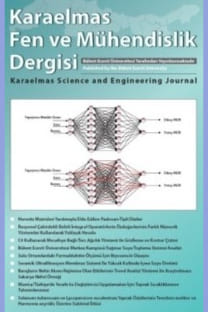Pathogenicity of Four Entomopathogenic Nematodes Species to G. mellonella Larvae
Pathogenicity of Four Entomopathogenic Nematodes Species to G. mellonella Larvae
Galleria mellonella, Steinernema, Heterorhabditis, entomopathogenic nematodes encapsulation,
___
- Akhurst, RJ. 1982. Antibiotic activity of Xenohabdus spp., bacteria symbiotically associated with insect pathogenic Heterorhabditidae and Steinernematidae. J. Gen. Microbiol., 128: 3061-3065. of the families
- Boemare, NE., Givaudan A., Brehelin M., Laumond, C. 1997. Symbiosis and pathogenicity of nematode-bacterium complexes. Symbiosys, 22: 21-45.
- Burnell, AM., Stock, SP. 2000. Heterorhabditis, Steinernema and their bacterial symbionts – lethal pathogens of insect. Nematology, 2: 31-42.
- Campbell, LR., Gaugler, R. 1992. Effect of exsheathment on motility and pathogenicity of two entomopathogenic nematode species. J. Nematol., 24: 365–370.
- Cappaert DL., Koppenhöfer, AM. 2003. Steinernema scarabaei, an entomopathogenic nematode for control of the European chafer. Biol. Control, 28: 379-386.
- Dowds, BCA., Peters, A. 2002. Virulence mechanisms, Entomopathogenic International, Oxon, New York, pp. 79-98. nematodology, CAB
- Dunphy, GB., Thurston, GS. 1990. Insect immunity, In: Entomopathogenic nematodes in biological control, CRC Press, Boca Raton, Florida, pp. 301- 323. Kaya HK. [eds.]
- Dunphy, GB., Webster, JM. 1987. Partially characterized components of the epicuticle of dauer juvenile Steinernema feltiae and their influence on hemocyte activity in G. mellonella. J. Parasitol., 73: 584-588.
- Dunphy, GB., Webster, JM. 1998. Virulence mechanisms of Heterorhabditis heliothidis and its bacterial associate, Xenorhabdus luminescens, in non-immune larvae of the greater wax month, Galleria mellonella. I. J. Parasitol., 18: 729-737. Ehlers, RU. entomopathogenic protection. Appl. Microbiol. Biotechnol., 56: 623-633. for nematodes plant
- Gerritsen, LJM., Wiegers, GL., Smits, PH. 1998. Pathogenicity of new combinations of Heterorhabditis spp. and Photorhabdus luminescens against Galleria mellonella and Tipula oleracea. Biol. Control, 13: 9-15.
- Gupta, AP. 2002. Immunology of invertebrates: Cellular. Encycklopedia of Live Sciences, J. Willey and sons. Ltd., p. 9.
- Gupta, AP. 2001. Immunology of invertebrates: Humoral. Encycklopedia of Live Sciences, J. Willey and sons. Ltd., p. 6.
- Haydak, MH. 1936. A food for rearing laboratory insect. J. Econ. Entomol., 29: 1026.
- Kaya, HK. 1990. Soil ecology, In Gaugler R., Kaya HK. [eds.], Entomopathogenic nematodes in biological control. CRC Press, Boca Raton, Florida, pp. 93-115.
- Koppenhöfer, AM., Fuzy, EM. 2003. Steinernema scarabaei for the control of white grubs. Biol. Control, 28: 47-59.
- Li, XY., Cowles, RS., Cowles, EA., Gaugler, R., Cox- Foster, DL. 2007. Relationship between the successful infection by entomopathogenic nematodes and the host immune response. Int. J. Parasitol., 37: 365-374.
- Narayanan, K. 2004. Insect defence: its impact on microbial control of insectpests. Curr. Sci. India, 86: 800-814.
- Peters, A., Gouge, DH., Ehlers, R., Hague, NGM. 1997. Heterorhabditis spp. infecting larvae of Tipula oleracea. J. Invertebr. Pathol., 70: 161-164. by
- Peters, A., Ehlers, RU. 1997. Encapsulation of the entomopathogenic nematode Steinernema feltiae in Tipula oleracea. J. Invertebr. Pathol., 69: 218-222.
- Strauch, O., Ehlers, RU. 1998. Food signal production of Photorhabdus luminescens inducing the recovery of entomopathogenic nematodes Heterorhabditis spp. in liquid culture. Appl. Microbiol. Biotechnol., 50: 369-374.
- Wang, Y., Gaugler, R. 1998. Host and penetration site location by entomopathogenic nematodes against Japanese beetle larvae. J. Invertebr. Pathol., 72: 313–318.
- Wang, Y., Gaugler, R. 1999. Steinernema glaseri surface coat protein suppresses the immune response of Popillia japonica (Coleoptera: Scarabaeidae) larvae. Biol. Control, 14: 45-50.
- ISSN: 2146-4987
- Yayın Aralığı: 3
- Başlangıç: 2011
- Yayıncı: ZONGULDAK BÜLENT ECEVİT ÜNİVERSİTESİ
Zbigniew ADAMSKİ, Jolanta KRAWİEC, Ewa MARKİEWİCZ, Michał BANKİET, Eliza RYBSKA, Marlena RATAJCZAK, Małgorzata GLAMA, Laura SCRANO, Sabino A. BUFO, Kazimierz ZİEMNİCKİ, Meltem ERDEM, Ender BÜYÜKGÜZEL
Pathogenicity of Four Entomopathogenic Nematodes Species to G. mellonella Larvae
